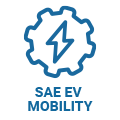
Cambridge EnerTech’s
EV Mobility 2030
SAE and AABC Joint Peer-Reviewed Technical Track
15-16 May 2024
SAE has partnered with AABC to host a technical track which will include peer-reviewed published papers on the latest research and development helping to drive future outcomes of electric vehicle batteries. In addition to the peer-reviewed papers, this track will featured in-depth market overviews and cutting edge presentations from industry veterans. Each year, AABC Europe brings together a global audience of battery technologists and their key suppliers for a must-attend week of development trends, breakthrough technologies, and predictions of the market for years to come. SAE provides thought leaders the opportunity to reach this target rich audience through its extensive peer-reviewed manuscript process so engineers can learn today and keep for long-term reference value in the future. It’s a great partnership! SAE relies on volunteer support to help organize technical presentations and panels. This year's organizers are Brian Engle from Amphenol and Vinay Premnath from UL.